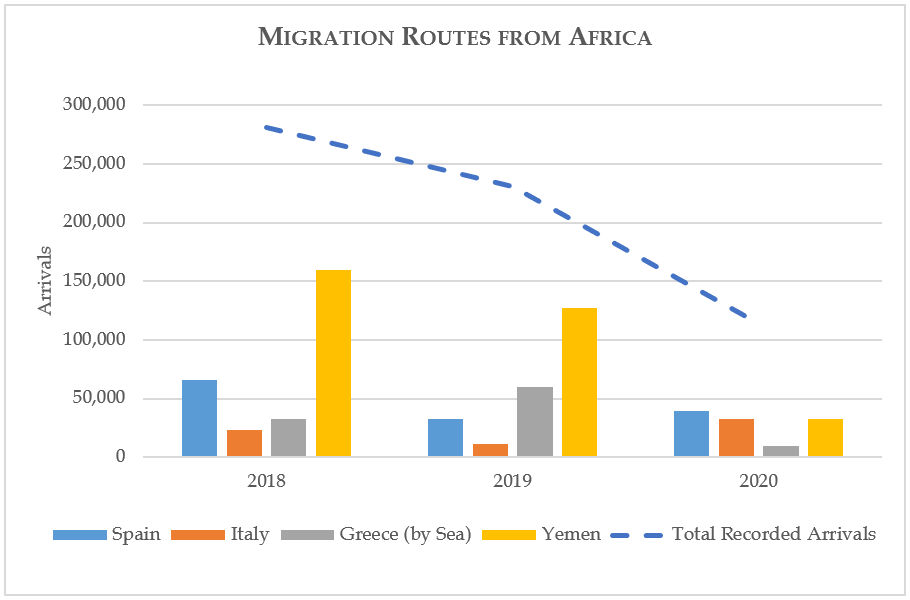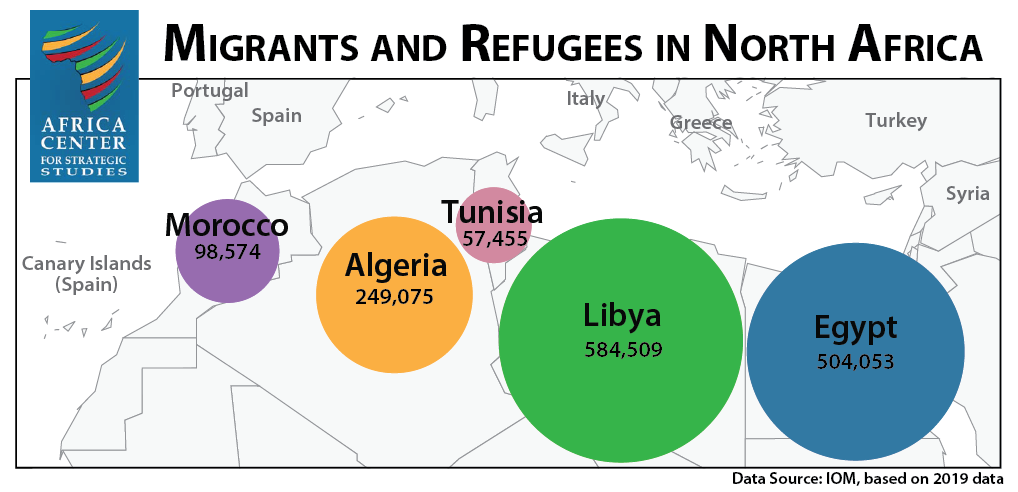Border closures in 43 of Africa’s 54 countries in 2020 have created more challenges for migrants traveling regionally for work
- These closures have trapped many migrants in unsafe situations and forced others to take migration routes that are more dangerous. Moreover, detentions and forced deportations from Algeria, East Africa, and the Middle East have left many migrants stranded in foreign countries.
- Experts believe pandemic-related mobility restrictions have created an increased risk of trafficking for migrants once the pandemic is over.
Most African migration remains intra-regional
- The vast majority of African migrants travel between African countries for short-term, economic purposes. Roughly 80 percent of African migrants stay in Africa.
Top 20 Migration Corridors Involving African Countries

Source: IOM, based on 2019 data.
- North Africa remains a top destination for migrants, with these countries collectively hosting between 1.5 to 2.5 million international migrant workers and refugees.
Migration off the continent dropped significantly in 2020
- Mediterranean Sea crossings dropped 20 percent in 2020 (to 81,502 arrivals) with African migrants comprising roughly half of those numbers. This continues a multiyear trend.
- The migration routes used to cross the Mediterranean have shifted from the Central to the Western Mediterranean. This includes more dangerous routes such as from West Africa to the Spanish Canary Islands. One in every 16 persons on that journey has gone missing or died.
- Sea crossings from the Horn of Africa to Yemen fell by 97 percent between the first and third quarters of 2020 (from 27,948 to 888) and have remained low since, largely due to COVID-related border restrictions.

Data Sources: UNHCR and Mixed Migration Centre
African cities continue to show leadership in protecting migrants and refugees
- The Mayors Migration Council Leadership Board, which includes the mayors of Freetown and Kampala, called for a global COVID response inclusive of migrants and refugees in July. This is an example of cities engaging in international advocacy to improve the lives of their constituents, many of whom are migrants and refugees.
- As part of the Mayors’ Dialogue on Growth and Solidarity, mayors from 20 African and European countries are collaborating to create mutually beneficial opportunities for their constituencies. Milan and Freetown are working to support Milan fashion industry investment in Freetown talent. Bristol and Durban are working to address housing shortages, quality issues, and financing.
- Mayors have realized that they do not have to wait for their national governments to shape policies on global migration and are instead reaching across borders to help one another achieve common goals.
Additional Resources
- “Mixed Migration Review 2020,” Chris Horwood, Bram Frouws, and Roberto Forin (eds), Geneva: Mixed Migration Centre.
- Global Migration Data and Analysis Centre (GMDAC), “Migration in West and North Africa and across the Mediterranean,” IOM 2020.
- African Union Commission and IOM, “Africa Migration Report: Challenging the Narrative,” IOM, October 15, 2020.
- Wendy Williams, “Shifting Borders: Africa’s Displacement Crisis and Its Security Implications,” Africa Center Research Paper No. 8, Africa Center for Strategic Studies, October, 2019.
More on: Migration


